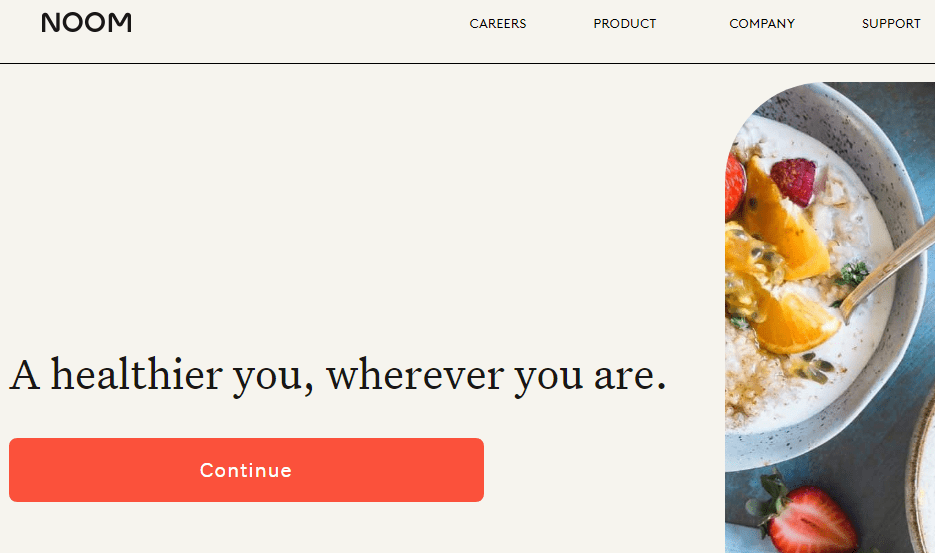Trying to lose weight is not an easy road to travel. It has its complexities, and that is why we still struggle a bit with how to do it right. With fad diets emerging left and right, choosing the best one for you and your body type could be intimidating. Mostly, these weight loss plans help you lose weight by cutting certain things from your diet, from carbohydrates to sugar, fats, and calories. But what if our approach to losing weight is wrong? What if, instead of approaching weight loss with what we think is an appropriate diet plan, we approach it with psychology and with the help of a mobile application designed to be the “last weight loss program you’ll ever need”?
And that is what the weight-loss app Noom is all about.
So, what is Noom Diet?
Noom is a weight loss app that promises its users’ long-term results when it comes to losing body fat by encouraging daily behavioral changes. There are already a number of mobile applications that could help you macro-track, wherein you can log your meals or your food intake on these apps, and they will help you stay on track with your diet plan and lead you to your fitness goal. But bold is the promise of Noom, which separates it from the rest. This application has its own personalized weight loss plan, the “Noom Diet,” and it is gaining fame for its daring claim that it could help users get “life-long results.” As mentioned, Noom will be the “last weight loss program you’ll ever need,” according to their website. It is also stated there that Noom uses technology “to help you change not just how you eat, but how you think.” Debuting in 2008 as a mere calorie tracker, Noom is now boasting more than 50 million downloads as of 2021 and has been downloaded in more than 100 countries, such as the U.S., the U.K., Australia, New Zealand, Canada, and Ireland. The app mainly focused on simple fitness from its debut, and only added more features such as the psychology and behavioral change component, personal coaches, and support group by 2016. What sets Noom apart from other weight-loss applications is that its main purpose is that, instead of telling you what to eat and how to exercise, its mind psychology will help you lose weight through building healthy habits. Noom assigns every user, after filling out goals, a calorie count to achieve daily, along with suggested revisions on how to exercise and what to eat. The app also uses a color-coded database, categorizing countless numbers of food selections based on their nutritional value. The app’s philosophy says, “Once you determine the things you are ready to work on, your mindset will help you form new neural connections over time to change your habits.” So before focusing on meals, Noom diet followers will have to first learn to focus on their mindset with the help of Noom’s very own team of behavioral experts, with the aim of pinpointing the very cause of every user’s struggles in terms of weight loss. This is backed up by their research in diabetes management and prevention, hypertension, oncology, and many more.
What to expect upon downloading the Noom app:
When downloaded, the app will ask you some questions about your activity levels. It will also ask you to enter your basic information such as height, weight, age, and gender, your general health information such as your risk for conditions including heart disease and diabetes, goal weight and why you want to achieve it, and other aspects of your life into it such as your social circles. In the app, you will have to log your meals and exercise, this will help the app provide you with feedback on your food choices and will help you target your weight goal by eating better. The app also features a built-in pedometer to track your every step, and will also give you recommendations on how to get more exercise. Noom also has a messaging feature, this is helpful when it comes to communicating with a personal trainer from the app who will reach out to you twice a week or so, checking in on your progress. Your personal coach will also be there to motivate you in achieving your goal by helping you overcome every hurdle on your way. The messaging feature will also enable you to talk to other app users through a virtual support group that is moderated by an assigned group coach. Your group coach may also sometimes respond to individual questions and comments and will be there to share more tips on losing weight.

What are the foods you can eat on Noom?
Unlike other weight-loss apps, Noom does not necessarily tell you what food to eat and not eat. Instead, the app and the company behind it use color-coding (yellow, green, and red, each color is based on their nutrient count) to help you determine which food might help you lose weight and which ones will prevent you from your weight loss goals. Basically, the app will tell you which food group choices have low calorie and high nutritional value. The idea behind it is that the researchers of Noom believe that food weight determines how full you feel, and not the calories that it contains. Thus, the explanation behind the color coding of food, prioritizing each color by its caloric density. Meaning, the more water the food contains, the lower caloric density (CD) it has. So by eating food with low CD, you will get full faster, with lesser calories.
Green Food:
Low calorie dense food, such as fruits and vegetables. This suggests that they’re higher in water content and contain the highest concentrations of nutrients. Examples are bananas, apples, strawberries, bell peppers, spinach, whole-grain bread, brown rice, nonfat yogurt, unsweetened almond milk, and tofu for protein.
Yellow Food:
Having more calories, and lesser nutrients than green food, food such as dairy, meats, and legumes should be eaten moderately. Examples are lean ground beef, grilled chicken and turkey breast, eggs, tuna and salmon, black beans, chickpeas, Greek yogurt, and low-fat cheese.
Red Food:
The most calorie-dense food with a very little amount of healthy nutrients should be eaten less often and in smaller portions. A half-cup of servings of these foods is already 25% of your daily calories. Examples are coconut oil, avocado oil, chia and sunflower seeds, nuts such as almonds, walnuts, cashews, peanut butter, and almond butter.
In Conclusion
With the app, you have to log literally everything you eat and the amount of exercise you do so it can calibrate these data and provide you with the right feedback and advice. The app is not very hard to use, even if you are not tech-savvy. And with the help of your very own Noom coach, staying on track with your fitness goal wouldn’t be so difficult. Noom offers a free trial period of 2 weeks, but after that, the app will cost $59 a month. They also offer a three-month subscription promo for only $129. The effectiveness of Noom’s personalized plan has been the subject of some research, suggesting that 78% of the app users have actually lost weight, with 23% of them claiming they have lost more than 10% of their body weight. In Noom, your weight loss goals will be achievable. And that power is in the palm of your hand, on your phone. Noom will help you lose weight by identifying what’s keeping you from it and will help you make real changes.
Sources: https://www.medicalnewstoday.com/articles/327114#how-it-works https://www.webmd.com/diet/a-z/noom-diet https://www.forbes.com/health/body/noom-diet-review/ https://www.womenshealthmag.com/weight-loss/a21604221/what-is-noom/ © 2016-2022 by DietFind.com, a LIVenture LLC. All rights reserved. No part of this document may be reproduced or transmitted in any form or by any means, electronic, mechanical, photocopying, recording, or otherwise, without prior written permission of LIVentures LLC.

